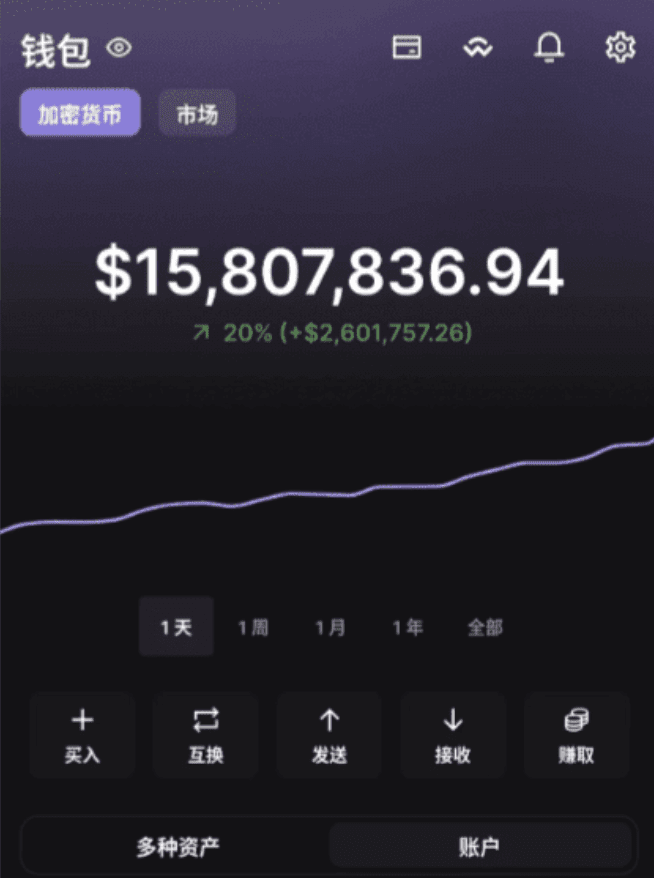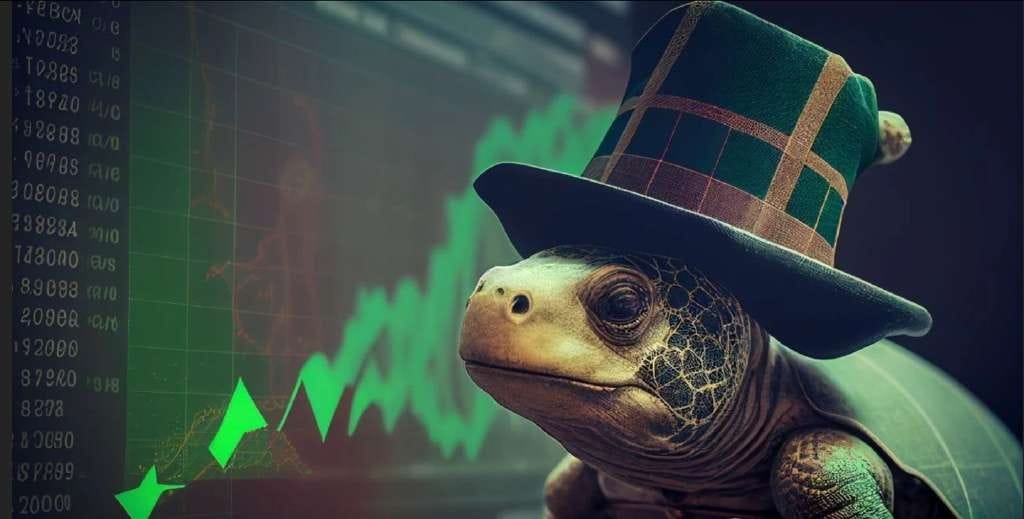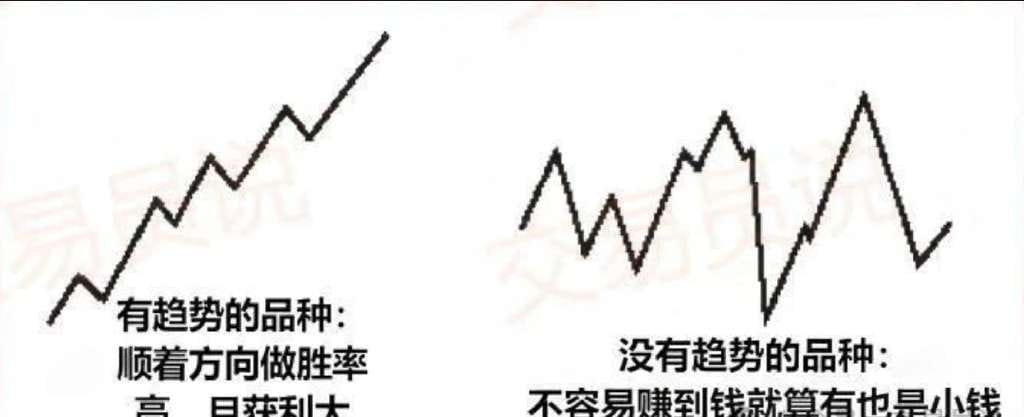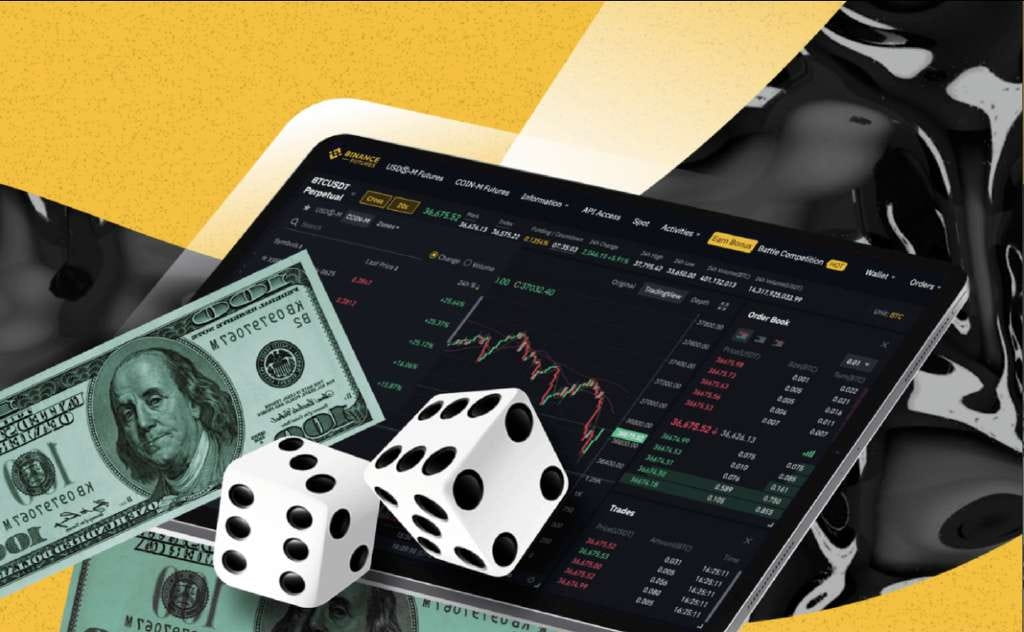From initially entering the crypto world at 8000 to now achieving wealth freedom, a leap in class! A trading strategy that I have consistently used for 10 years; the multi-cycle analysis method, simple three steps to clarify trends, lock in ranges, and seize opportunities.

Many people repeatedly make mistakes in investing, often because they focus only on a single time dimension to analyze trends.
Why refer to the weekly, daily, and 1-hour lines?
Today, I share the multi-cycle analysis method I often use, simple three steps to clarify trends, lock in ranges, and seize opportunities.
1. Weekly line: Determine the overall direction.
This cycle has a long time span and can effectively filter out short-term fluctuations, clearly showing the overall trend:
• Upward trend: High points continue to rise, while the low points of pullbacks also keep moving up → Consider positioning during pullbacks.
• Downward trend: low points are continually refreshed, rebound high points are gradually lowered → Prepare for response during rebounds.
• Sideways fluctuations: Prices oscillate within a certain range, making it easy to get trapped repeatedly, and frequent trading is not recommended.
Remember one thing: only by operating in accordance with the main trend can you increase your success rate; acting against the trend often leads to losses.
2. Daily line: dividing key areas, seeking support and resistance levels.
Once the main direction is determined, the daily chart can help lock in specific trading areas:
• Positions near trend lines, important moving averages, previous low points, etc., are potential layout opportunities.
• When approaching previous high points, key resistance levels, or when top formations are forming, consider taking profits or adjusting strategies.
3. 1-hour line: responsible for the precise timing of operations.
This cycle is specifically used to grasp specific entry points rather than to judge trends:
• Wait for key price levels to show small cycle reversal signals (such as bullish engulfing, bottom divergence, indicator golden cross, etc.) before taking action.
• Breakthroughs with accompanying trading volume are more credible; otherwise, they may be false signals of short-term inducement.
How to coordinate multiple cycles?
1. Determine the main direction: use weekly lines to judge whether the overall trend is upward, downward, or sideways.
2. Lock in the trading range: use daily lines to outline support or resistance areas.
3. Precise operations: use the 1-hour line to find suitable entry signals.
A few additional points:
• If trends across multiple cycles are inconsistent, it is better to remain on the sidelines than to engage in uncertain operations.
• Short-term cycles fluctuate quickly and have high uncertainty; be sure to manage risk and avoid excessive losses.
I have used this multi-cycle analysis method for over three years; it is an important foundation for steady operations. Whether it can be used effectively depends on whether one is willing to spend time on more reviews and summarizing the rules within.
From 7500U to 150,000U, I don’t look at K-lines, just focus on a 'Blockchain Wolf King Chart'!
"In three months, 25 people recouped their investments, 3 resigned to follow me—this 'Wolf King Tracking Technique' will be fully revealed tonight!"
While most people are still staring at K-lines guessing price movements, I have used 7500U capital + a blockchain holding table + a three-line code filter to achieve a 1900% return!
Today, I will break down this 'Counter-Human Nature High-Profit Model' (coordinates of the Wolf King attached at the end):
Core logic: Eat meat with the Wolf King, do not compete with retail investors for scraps.
Wolf King = Top ten addresses on the blockchain, they are the market's 'carriers'—if the Wolf King does not move, retail investors cannot stir up any waves.
My filter consists of only three lines of code, but the winning rate exceeds 80%:
Prices halved within 72 hours: retail investors collectively surrender, chips are relocated.
At the same time, trading volume has tripled: institutions begin to take over; the sharp drop is a 'fake fall.'
Top ten addresses holding positions unchanged: the Wolf King remains still, waiting for 'lifting the sedan chair.'
When the lights flash simultaneously, I place an order directly, with a position size of 30%, stop loss at 2%, and take profit at 20% with automatic splitting.
Execute discipline: lock your emotions in a cage.
Stop loss cut at the neck: if loss is 2%, get out immediately, never 'wait to break even.'
Take profit in batches: break profits at 20%, sell 1 part for every 4% increase.
Set orders and turn off the computer: go for a walk, have tea, sleep; let the market run itself.
Public trading results: 82 trades, 68 profitable, maximum drawdown only 5% of capital!
The truth of high profits: in the darkest emotional moments, doubling opportunities arise.
When the screen is filled with cries of despair, I click 'buy' (retail investors panic sell; the Wolf King takes over).
When people in the group start talking about an 'eternal bull market,' I click 'sell' (the Wolf King distributes, retail investors take over).
Remember: it's better to watch the Wolf King than to watch the market; complex indicators are inferior to a simple position line!
True masters are driven by both 'strategy and discipline'!

From 200,000 to 20 million, I used this method with a 95% winning rate (Turtle Trading Method), which has consistently worked, and I am still using it now, becoming more skilled and proficient. I am sharing this with those destined to learn the skills, hoping you can truly master the technique and avoid wasting 10 years in the crypto world!
Go with the trend and win by adding positions: teach you how to achieve big wins with small losses? Build a profitable system using Turtle Trading Method.
Without further ado, let’s get straight to the valuable content!

Moving averages can bring profits in trending markets because they align with the principle of 'trailing stop losses.'
Trading is attractive to most people, but market trends are filled with uncertainties. We want to earn profits while fearing losses. As Einstein said, 'Doing the same thing over and over again while expecting different results is the definition of insanity.' Yet in the trading world, we often perform the same operations, but the results can vary greatly: sometimes we succeed greatly, and sometimes we fail. Frustratingly, we often miss opportunities for success while getting trapped in failures. So how should we cope with such uncertainties?
No matter what assets are traded, the essence of making profits from price differences is based on probabilistic thinking. The correct timing of price movements, whether to buy, and even whether the trend can sustain are all probabilistic events. Since uncertainty is inherent, we must base our actions on probability, reasonably assess risks and rewards, and effectively control risks to achieve stable profits in the market. Understanding and accepting the randomness of the market and flexibly adjusting strategies are key to dealing with complex market conditions.
In fact, trading (investing) is somewhat like gambling; after all, it is a large 'casino' that is publicly regulated, attracting hundreds of millions of participants. This is not a derogatory term but a direct acknowledgment of reality, thinking positively about how to profit within it. Only by viewing trading through the lens of winning in a casino can one achieve excellent results. Otherwise, many people superficially think they are investing but are actually acting like gamblers, ultimately losing all the money in their pockets.
(Turtle Trading Rules: Revealing the Success Secrets of Making Hundreds of Millions) author Curtis M. Faith, a disciple of renowned commodity trader Richard Dennis. Richard Dennis is known as the 'Prince of Futures Trading' and turned several thousand dollars into hundreds of millions by his thirties. He made a bet with his friend, fellow professional investor William Eckhardt. Dennis firmly believed that systematic training could turn people with no trading experience into excellent traders, while Eckhardt believed it was a gift that couldn't be acquired through training. Thus, they initiated the famous 'Turtle Experiment' to validate this view.
Back then, Richard Dennis and William Eckhardt, to validate whether 'excellent traders can be cultivated,' published large ads in (The Wall Street Journal) and (The New York Times), openly recruiting students, claiming to be looking for successors and passing on their trading secrets. Even more shocking, each trained student was provided with $1 million in real funds by Dennis, allowing them to trade according to his methods. This experiment later became known as the 'Turtle Program' and was a massive success, creating a sensation in the trading community—within just four and a half years, this group of students known as 'Turtles' achieved an average annual return rate exceeding 80%.
One of the most outstanding students—Curtis M. Faith later published (Turtle Trading Rules: Revealing the Success Secrets of Making Hundreds of Millions), which meticulously records Dennis’s teaching philosophy and practical strategies. This book not only tells the core principles of 'Turtle Trading Method' but also demonstrates how to achieve stable profits through systematic trading in a highly uncertain market environment.
Gamblers rely on luck; players rely on calculations and discipline.
In the 'Turtle Experiment,' most of the students Richard Dennis selected had no financial or trading background; they came from various industries, including computer game players, chess champions, linguists, accountants, professional blackjack players, and programmers. These individuals shared a common trait: they possessed a mindset related to gambling and game strategies, understanding the relationship between probability, risk, and odds. This background played a significant role in trading because the market is fundamentally a probability-driven game, and those who understand strategy, discipline, and risk management are more likely to stand out.
When talking about gambling, one must mention a saying from the professional gambler known as 'Taiwan's God of Gambling,' Dai Zilang: 'I look down on gamblers the most because gamblers rely on luck, while professional players rely on calculation and discipline, only betting on games with winning chances.' This statement almost precisely describes successful traders. Whether it is capital management, trading discipline, or only choosing to bet on 'advantageous' trading opportunities, these principles are identical to those of professional gamblers. By this standard, I believe that if Dai Zilang entered the financial market, he would definitely be an outstanding investor.
In the world of investment trading, operating from a probability perspective greatly enhances the likelihood of long-term profitability. First, improve the winning rate by betting only in 'games with a chance to win,' that is, only taking action when favorable conditions appear in the market. Secondly, overcome human weaknesses such as greed, fear, and impulsiveness. While this part is difficult to change, only through continuous practice and self-awareness can one gradually establish the habit of rational execution. Finally, the key is to optimize the profit-loss structure: maximize profits when you are right, and minimize losses when you are wrong. To turn these concepts into executable actions, it is essential to establish a clear SOP (Standard Operating Procedure). I will compare my own SOP with the Turtle Trading Rules for deeper understanding of how to translate probability advantages into practical results.
First, increase the odds.
In improving winning rates, the most critical step is to choose assets with clear trends for trading. As Curtis M. Faith, the author of (Turtle Trading Rules), said, his trading performance far exceeded that of other Turtle students, not because he mastered special methods, but because he understood how to select trending targets for trading. All Turtle students learned the same system; the difference lies in execution details and asset selection. Trading trending assets not only improves winning rates but also expands profit margins; conversely, trading in directionless fluctuations not only makes profit difficult but also limits price differences, thereby restricting earnings.

Therefore, in cryptocurrency trading, I particularly prefer to operate on 'strong stocks' because these coins often have clear upward trends, higher odds, and the potential for a significant market movement. However, I also find that many investors are easily attracted to certain seemingly cheap or 'technically appealing' coins, which might be in a sideways, rebounding, or weak state, making them difficult to operate and low in success rates. If you can stick to only selecting assets with trends and good volume-price combinations when picking stocks, trading performance will often see a significant improvement.
① Downward trend, guess the bottom and enter.
Many traders like to 'guess the bottom' during downtrends and can’t help but want to pick up bargains when they see prices drop significantly. However, if the goal is to profit from price differences, the key is not the height or low of the price but the 'direction' of the price. Cheap does not equal an opportunity to rise; the reason the price is cheap is often because the market already has a clear expectation of its prospects. If you are doing long-term value investing, low prices may be attractive; but if you are trading short-term or in waves, such 'cheapness' that falls from the sky is mostly a trap rather than a gift.
② Previously a strong stock, now enter after a significant drop.
Another common misconception is entering the market to pick up bargains after a strong coin has dropped significantly. Although these coins once had strong momentum, they no longer have a 'strong' structure after a significant drop. Many people fail to enter at peak prices, and when they finally wait for the stock price to correct, they rashly buy in, ignoring the risk of trend reversal. Once the original bullish structure is disrupted, the odds of success will greatly decrease. Even if there is a subsequent rebound, it might only be a technical rebound, quickly encountering trapped selling pressure forming a right shoulder. For this type of coin, if trading, it should be primarily 'short trades'; extending the trading cycle will only lower the winning rate. A comfortable price does not equate to having a 'probability advantage' in trading.

Overcoming human weaknesses.
Operating according to human nature, most traders ultimately become losers in the market. When faced with losses, many choose not to stop losses and stubbornly hold on, hoping the market will automatically reverse by the next day; conversely, when they see profits, they are quick to exit due to the pleasure of realizing profits. Once they see profits decrease, they will hastily cash out out of fear of loss. This instinct to avoid danger ultimately leads to: procrastinating on stop losses during losses, leading to significant losses; exiting early when seeing profits, resulting in small gains. Over time, it becomes naturally difficult to achieve stable profits.
It was only by realizing the problems with this behavioral pattern that I decided to 'do the opposite of myself,' consciously overcoming human weaknesses and re-establishing trading habits. From originally fearing stop losses to forcing myself to actually implement them; from the habit of taking small profits to training myself to hold onto profitable positions. This transformation gradually freed me from the constraints of retail thinking, allowing me to achieve stable profits.
"Doing the opposite of what you usually do" is not just a slogan but requires transforming abstract concepts into concrete, executable actions. For example, if you are used to not setting stop losses, you must reverse that habit by establishing clear stop loss points and strictly enforcing them; if you usually close positions after a small profit, you must learn to hold onto profitable positions. If these concepts cannot be implemented as an SOP (Standard Operating Procedure), they remain mere talk. The difficulty in trading lies not in understanding the theory but in whether one can consistently apply it in practice. Investing is not an innate instinct; no one is born a trader. The ability to achieve stable profits must be developed through continuous training and discipline.
The essence of Turtle Trading Rules: big wins, small losses as the principle.
My trading SOP includes three basic and crucial execution steps:
First, strictly adhere to risk management principles;
Second, set a clear stop loss point upon entering the market;
Third, adopt a trailing stop loss approach to lock in profits.
The first point is to protect capital and avoid major damage from a single loss; the second and third points, when implemented, can help us achieve 'small losses, large profits.' This is the key path to help us earn more and lose less.
These core practices not only apply to my trading system but are also highly consistent with the Turtle Trading Rules. Turtle traders emphasize risk management, clear stop losses, and trailing stops in trend-following. In fact, whether it’s the Turtle Trading Method, Jesse Livermore’s approach, or Soros’ capital management logic, although the technical details may vary, the underlying trading core structure is the same—valuing risk, executing discipline, and following the trend. Winners’ methods are never based on luck but are established on a disciplined, repeatable system that can cope with uncertainties.
Each trade complies with risk management.
In trading, the first step is to control every trade within an acceptable risk range. I personally set the risk for a single trade at no more than 2% of my account funds, and the lower, the better. The key is to know clearly beforehand how much you will lose if this trade goes wrong. If you can't even estimate the maximum potential loss, you're not trading; you're gambling. We are not gamblers; we aim to be smart players, participating in the market with plans and discipline.
Real players know how to calculate their 'chips'—that is, available funds and how many more times they can act. They do not participate in every round but carefully select those with a higher probability of winning. In contrast, many inexperienced investors always want to 'play every hand,' fantasizing about catching every profitable opportunity, but neglecting that every action is a resource expenditure, either making money or losing it. Trading is like strategic planning; you are either preparing for success or executing a failed plan. Only by cherishing each opportunity to enter can one proceed steadily in the market.
Real players know how to choose favorable moments to bet and excel at chasing victories, using the funds they won to further expand profits while emphasizing the protection of principal. The core of trading lies in how to allocate bets reasonably, flexibly expanding or contracting positions. Regardless of how much you bet, the most important thing is always to keep 'total losses within an acceptable small range,' which is the art of trading.
Risk planning must be prepared before trading actions occur. This means setting a maximum acceptable loss range in advance and then combining it with specific stop loss prices and position sizes to calculate the maximum risk amount for that trade. Conversely, you can also deduce the maximum position size you can buy based on the maximum risk you can bear and the stop loss distance. Through scientific risk planning, traders can navigate the market deftly and avoid significant losses due to excessive risk-taking.
Position × Stop Loss Price Difference ≤ Total Capital × Risk %
If the capital is 1 million, and the risk percentage is 2%, if each stop loss amount is 5000, how many positions can you buy at most? The answer is 4 positions.
Position = (Total Capital × Risk %) ÷ Stop Loss Price Difference Position = (1 million × 2%) ÷ 5000
=20000÷5000
=4

If your stop loss distance is large, leading to potential losses of up to 10,000 yuan per order, you must accordingly reduce your position size. For example, if you initially planned to buy 4 positions, you can only reduce it to two to ensure overall risk is within a controllable range. Controlling risk is always the first step in trading. The biggest mistake many investors make is not having a clear stop loss plan and failing to accurately calculate potential risks. Trading without a stop loss plan is merely gambling. I do not believe there is any 'certain' or 'guaranteed' way to predict price movements in the market, as the factors influencing prices are extremely complex and variable.
The essence of trading is a game where many participants collectively influence price movements. You cannot predict who will make a key move at what time. What we can do is make reasonable judgments based on limited information, seeking to bet on probabilities that favor us while strictly controlling losses within an acceptable range. This step is not only the starting point of trading but also the most important foundation; only by strictly adhering to risk management can one survive and profit in the market long-term.
Many traders often ask me if a particular asset is worth buying or holding now, and I usually counter with, 'Have you planned your stop loss point in advance? If you judge incorrectly, how much loss are you prepared to bear?' Most investors are concerned about which specific asset to buy and when to enter or exit the market, trying to predict future movements. However, professional traders focus on probability and are more concerned with risk control. The issues you focus on and the perspective from which you view them actually reflect your different levels in investment.
In fact, the future cannot be accurately predicted. Although we always make some predictions before trading, the market is full of uncertainties, and only by relying on scientific trading methods can we compensate for these uncertainties to achieve stable profits. With the accumulation of experience, one can even stop relying on predictions and choose targets and directions randomly, much like throwing darts or flipping coins, while still profiting in the market through a complete trading system and discipline. This is the essence of trading—relying on methods and probabilities, rather than blindly guessing the future.
Must-read for cryptocurrency trading! 7 ultimate skills to open the breakthrough for wealth freedom.
The crypto world is a battlefield and a wealth pool! Some lose everything, while others earn double effortlessly; the difference lies in these 7 validated practical strategies! Mastering these strategies can turn 'trading coins' into a guaranteed cash machine!
1. In uncertain situations, hold still!
The temptation in the crypto world is like a fog bomb; blindly following the trend = sending oneself to death! When the market's rise and fall signals are confused, staying out and observing is the optimal solution. Focus on key indicators and wait for trends to clarify before taking action; it’s better to miss 10 opportunities than step on a landmine once!
2. Popular coins, lightning trading rules
Hot coins are like skyrocketing rockets; they rise quickly but drop harder! Participation in speculation must be quick in and quick out, setting strict take profit and stop loss lines. The moment the heat fades, immediately liquidate positions; don’t let the profits turn into a nightmare of being trapped at high levels!
3. In a bullish market, lying back to win is king.
High opening K-line + surge in trading volume = rocket launch! At this time, it is most taboo to operate frequently; sit tight and let the profits run. Do not be scared off by short-term fluctuations; holding onto your chips is essential to enjoying substantial gains!
4. A huge bullish candle, cash out when seeing profits.
Regardless of high or low positions, a huge bullish candle = danger warning! This is a common tactic for major players to offload; once it appears, cash out immediately. Being greedy for one more second could lead to total loss!
5. Moving average operations, precise targeting.
Moving averages are the 'x-ray' for retail investors! Keep an eye on daily average support and resistance levels, with quick in-and-out trades over 3-7 days. Buy on golden crosses and sell on death crosses; let data replace intuition and say goodbye to chasing highs and cutting losses!
6. Trend is king; operate against human nature.
If the upward momentum has not diminished, do not sell; if the downward trend stabilizes, buy in batches! Don’t let panic or greed control you; strictly execute discipline—99% of those who operate against the trend become casualties!
7. Build positions in batches, small bets for big gains.
Going all in feels good for a moment, but leads to a zero-balance funeral! Entering the market in batches can both average costs and capture more opportunities. Plan your stop loss strategy before each trade, using minimal risk to leverage maximum profits!
Iron law for surviving in the crypto world: technology is the weapon, mindset is the armor! Keep this secret close; the next protagonist of wealth freedom is you!
